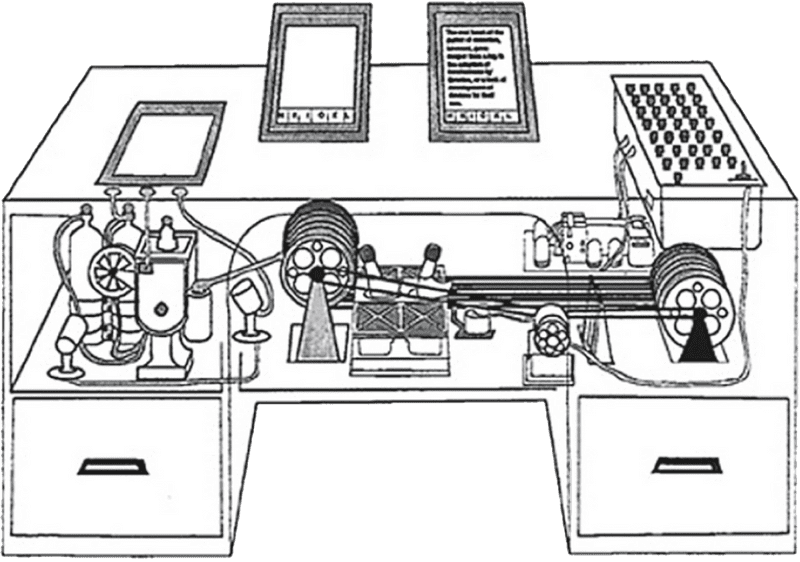How to Make a Memex

Vannevar Bush’s 1945 essay “As We May Think” prefigured the invention of hypertext and the Internet.
He imagined a “memex”, a desk equipped with a microfilm apparatus, “in which an individual stores all his books, records, and communications, and which is mechanized so that it may be consulted with exceeding speed and flexibility. It is an enlarged intimate supplement to his memory.”
The memex allows its owner to link to sources and comment on them. This way, he can record, for his own recollection, what he was reading and how it was relevant to questions he was thinking about. He can create “trails” of research questions, which contain links and excerpts to various sources he finds along the way. And these personal trails can be copied and shared with others, to put into their own personal memexes.
Arguably the Internet forms one big memex today. Bush was right in his prediction that “wholly new forms of encyclopedias will appear”, that “The patent attorney has on call the millions of issued patents,” and “The physician, puzzled by a patient’s reactions, strikes the trail established in studying an earlier similar case, and runs rapidly through analogous case histories, with side references to the classics.”
But Bush imagined the memex as a private (though shareable) record, not a communal one. Each person should have their own memex.
This matters because people need complex private thought.
Nicholas Carr, concerned about the effect of the Internet on human cognition, argues that a “complex personality” is actually the result of forming one’s own interpretations of what one reads, forming a private “cathedral-like” structure, a “personally constructed and unique version of the entire heritage of the West.”
Educated men and women of the 19th century worked at constructing inner lives through text. They kept diaries. They wrote letters. They kept files so they could remember what they were writing at different points in their lives.
Today, educated people also read and write a lot, but in an ephemeral and exposed fashion. Social media has a short memory. The defaults don’t permit you to organize your own space. Moreover, the demands of immediate sharing with everyone mean that you’re constantly modeling what other people will think of your writing. Not only are you incentivized away from writing controversial things, but also of writing anything that might be confusing or involve a large inferential distance from the audience. Long and nested chains of reasoning are hard to convey to all readers. Private concepts that you’ve invented are too “jargony” and people may criticize you for “needlessly” inventing terms. If you do all your thinking in public, in venues where you always have to start from a presumption of zero familiarity with your other thought, you can’t create complex thoughts at all.
The “intimacy” Bush wrote about is lost. You get dumber if your thoughts are limited to the bandwidth that you can successfully communicate in a few minutes to arbitrarily many strangers.
The solution is to create a personal memex. A record of your thoughts and associations, which you will only share parts of with others.
I use Roam for this.
(I know the founders but I’m not paid to promote Roam; I just genuinely love the tool.)
Roam has two main features that make it better than a simple notebook or text document: links and indents.
Links, of course, allow you to make associations between pages. Infinitely threaded indents allow you to impose hierarchical structures of arbitrary depth.
This allows you to make and visualize a graph of all your notes.
Roam also has one important feature that nothing else I’ve used does – very low friction to making and linking new pages. A memex is only as good as your willingness to use it. If it’s clunky to take notes, you won’t. So, Roam has keyboard shortcuts for links and indents and other applications (like LaTeX markup!) It also has very rapid loading times, so it’s less irritating to use than a word processor or Google Docs. You can add and link pages as fast as you can type.
Mainly, I use my memex as a personal record of my thoughts. I make pages for concepts of interest, including references to people. (“Memex” has its own page.) On each day’s “daily notes”, I add links to things I read, my reactions to conversations or things I’ve read, worries on my mind, drafts of arguments (diagrammed out with heavy use of indents; supporting arguments are threaded beneath the claims they justify) etc. When I mention a concept, I tag the word so it links to the corresponding concept page.
I’ve noticed this allows me to think in a more nuanced way. When I don’t have to compress an idea to make it easier to communicate with others, I can allow it to have dependencies, exceptions, conditionals…all the sub-clauses that make it hard to fit in a tweet.
It also allows me to gain more temporal consistency – more sense of the commonalities between me-of-last-week and me-of-this-week, to remember when I keep coming back to the same thoughts, etc.
And it has the usual advantages of diaries – helps me process my emotions, helps me make sense of my thoughts, helps me keep track of my life.
Ultimately, I think it could be a replacement for a documents folder or Google Drive, though I’m not sure I’m quite ready to switch my whole text-based life into Roam. It’s certainly an upgrade from either a diary or a blog. I hope more people try it!